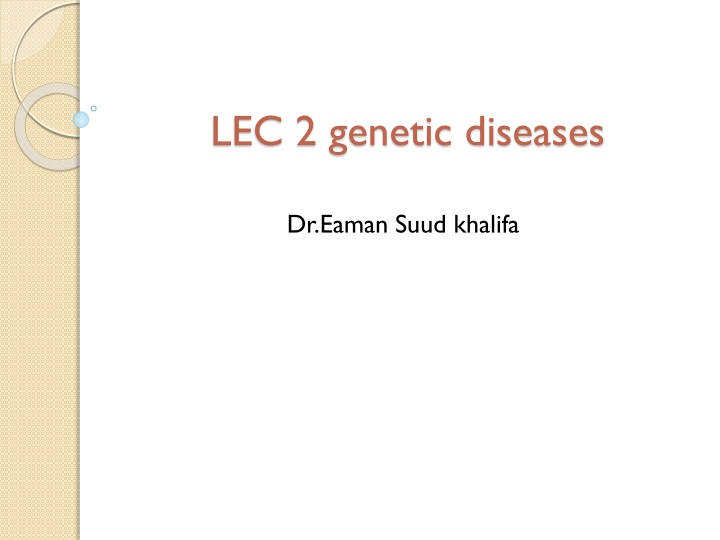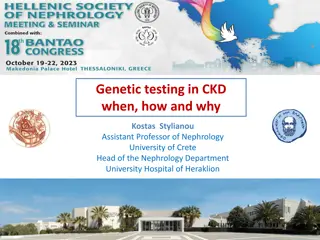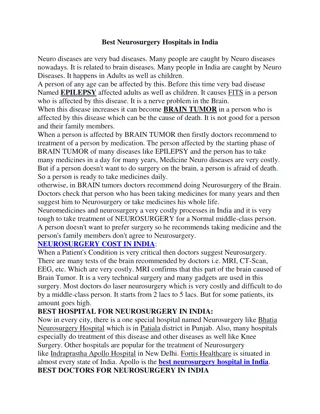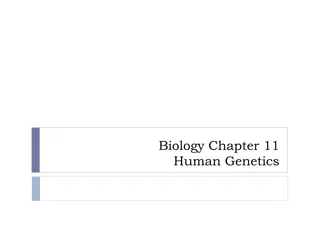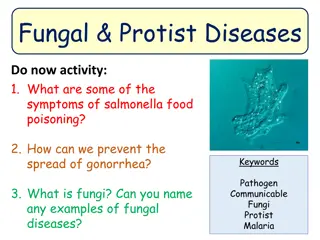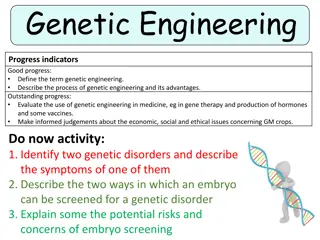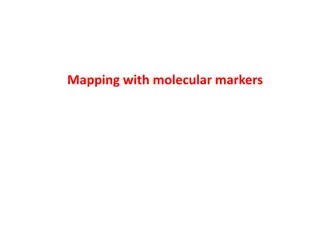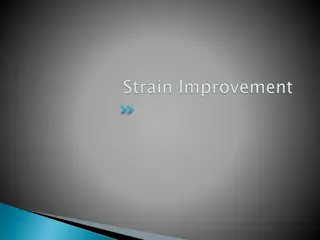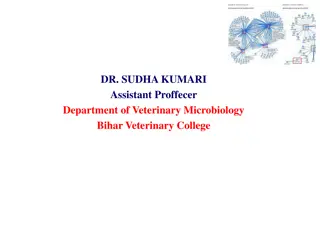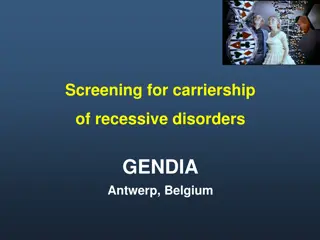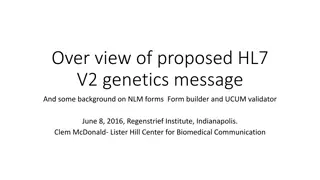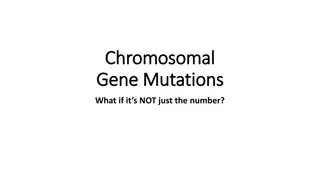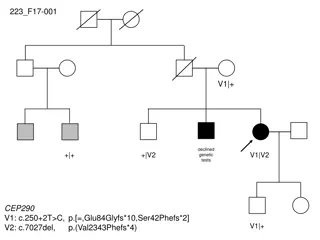LEC 2 genetic diseases
Diseases caused by mutations in structural proteins, such as Marfan syndrome, result in skeletal abnormalities, eye issues, and cardiovascular complications. Understanding the manifestations and implications of these genetic conditions is crucial for diagnosis and management.
Download Presentation

Please find below an Image/Link to download the presentation.
The content on the website is provided AS IS for your information and personal use only. It may not be sold, licensed, or shared on other websites without obtaining consent from the author.If you encounter any issues during the download, it is possible that the publisher has removed the file from their server.
You are allowed to download the files provided on this website for personal or commercial use, subject to the condition that they are used lawfully. All files are the property of their respective owners.
The content on the website is provided AS IS for your information and personal use only. It may not be sold, licensed, or shared on other websites without obtaining consent from the author.
E N D
Presentation Transcript
LEC 2 genetic diseases Dr.Eaman Suud khalifa
Diseases caused by mutation in structural proteins: Marfan"s syndrome: autosomal dominant disease of connective tissue (fibrillin), both quantitative &qualitative defects have been noted. 3 systems are mainly affected:
* Skeletal abnormalities: * Slender patient with long legs, arms &fingers, * high arched palate, * hyperextensibility of the joints kyphosis &the chest shows pectus excavatum or pigeon chest deformity.
Eyes: bilateral dislocation or subluxation of the lens due to weakness of suspensory ligament.
* Cardiovascular system: Fragmentation of the elastic fibers in the tunica media of the aorta---aneurysmal dilatation &aortic dissection. dilatation of aortic valve ring---aortic incompetence. mitral &tricuspid valves regurgitation---- congestive heart failure.
* Death from aortic rupture may occur at any age. * Variable expression of the features above between different patients.
AD DISORDERS Pectus excavatum in marfan syndrome
AD DISORDERS Lens dislocation &Marfan s family
Disease caused by mutation in receptor proteins: Familial hypercholesterolemia: 1- Autosomal dominant dis., heterozygotes have 2-3 folds elevation of plasma cholesterol level, remain asymptomatic until adulthood when develop xanthoma along tendon sheaths &premature coronary artery dis.
2- While homozygotes are much more severely affected, cutaneous xanthoma in childhood &dying from myocardial infarction MI in the age of 15 years. 3- It is caused by mutation in the gene that specifies the receptor for low density lipoproteins LDL.
4- Cholesetrol may be derived from diet or from endogenous synthesis, endogenous synthesis of cholesterol &LDL begins in the liver.
Normally, there is LDL receptors in the hepatocytes, so LDL binds to the receptors &formation of very low density lipoproteins VLDL which undergo lipolysis &converted into intermediate density lipopt. IDL, then to the liver (LDL receptor) again.
Mutation in LDL receptor gene--- accumulation of LDL cholesterol in the plasma, in addition the absence of LDL receptor on the liver impair the transport of IDL to the liver---accumulation of IDL that converted to LDL.
Familial hypercholesterolemia(xanthomas)
Diseases caused by mutation in enzymes proteins: Phenylketonuria(PKU) 1- Inborn error of metabolism, it is autosomal recessive dis. 2- homozygotes have severe lack of phenylalanine hydroxylase--- hyperphenylalaninemia &PKU
3- The affected infants are normal at birth but within few weeks to 6 months---increase phenylalanine in plasma with severe mental retardation, inability to walk, inability to talk, seizures, decrease pigments of the skin &hair, eczema, musty odor of sweat.
4- Deficiency of the enz.---inability to convert phenylalan. into tyrosine, when this is blocked, minor shunt to other pathways which lead to intermediates that excreted in sweat (odor), concomitant lack of tyrosine---lack of melanin. Treatment: restriction of phenylalan. intake early in life.
5- Many clinically normal PKU patients treated with diet early in life &reach child bearing age, most of them have high serum phenylalan. because dietary treatment is discontinued after reaching adulthood, children born to them are mentally retarded &have many congenital abnormalities---maternal PKU.
Lysosomal storage disease: Lysosomes are the key component of the ((intercellular digestive They contain hydrolytic enzymes which are synthesized in the endoplasmic reticulum and transferred to the Golgi apparatus where they undergo post translational modifications that are of multiple steps. tract)).
The lysosomal acids catalyze the breakdown of a variety of complex macromolecules derived from cellular organells (autophagy) or from outside by phagocytosis. Inherited deficiency of a functional lysosomal enzyme leading to incomplete catabolism of the substrate leading to accumulation of a partially degraded insoluble metabolite within the lysosome.
The stuffed lysosomes with the macromolecule will get large &interfere with the normal cell function giving rise to what is called lysosomal storage disorders.
The distribution of the stored material &the organ affected are determined by 2 factors: 1- The Site where the material which should be degraded is found. 2- Location where most of the degradation normally occurs. e.g brain is rich in gangliosides, so defective hydrolysis of gangliosides leading to storage of this material within the neurons---neurological symptoms.
e.g defect in degradation of mucopolysacharides (which is widely distributed in the body)--- affect every organ. Because cells of the mononuclear /phagocytic system are RICH in lysosomes , such storage diseases will--- enlargement of these organs, i.e hepatosplenomegaly. The no. of lysosomal diseases are divided according to the biochemical nature of the accumulated material as follows:
1- Glycogenosis. Lysosomal enzyme defect ---accumulation of glycogen E.g pompes disease. 2- Gangliosidose. Accumulation of gangliosides e.g Tay-Sach disease.
3- Mucopolysacharidoses. Accumulation of mucopolysacharides, e.g Hurler & Hunter disease. 4- Sulfatidoses (sphingomylinosis). Accumulation of sphingomyline , e.g Nimmen Pick disease, Gaucher disease(which is the most commonly seen dis. Is caused by defficiency in Glucocerebrosidase) Each of these has its own clinical features
Glycogen storage disorders (Glycogenoses): An inherited deficiency of any of the enzyme involved in glycogen synthesis or degradation, result in excessive accumulation of glycogen or abnormal form of glycogen in various tissue.
Glycogen is most often stored within the cytoplasm or sometimes within the nuclei, one variant called Pompe dis.---lysosomal storage dis. because the deficient enz. localized to the lysosomes. Most glycogenoses are inherited as autosomal recessive dis. On the basis of pathophysiology they grouped into 3 categories:
1- Hepatic form: liver cotains several enz. that synthesize or break down glycogen, so deficiency of an enz. result in enlagement of the liver due to storage of glycogen &hypoglycemia due to failure of glucose production e.g Glucose 6 phosphatase enz. deficiency called Von Gierke disease
2- Myopathic form: In striated muscles glycogen derived by glycolysis, when enz. are deficient so glycogen storage dis. of the muscle (muscle weakness), typically characterized by muscle cramps after exercise &failure of the exercise to induce an elevation in blood lactate level due to block in glycolysis (McArdle disease) result from deficiency of muscle phosphorylase enz.
3- Two other forms of glycolysis do not fit into either of the above two, Pompe disease due to deficiency of lysosomal acid maltase so deposition of glycogen in every organ but cardiomegaly is prominent. Brancher glycogenoses is due to deposition of abnormal glycogen with effect on the liver, heart, muscles
Diseases caused by mutation in protein that regulate cell growth: 2 classes of genes that regulate cell growth: prooncogenes &cancer suppressor genes. mutation affecting these genes----tumor.
5% of all CA, there is mutation affecting certain tumor suppressor genes are present in all cells of the body including germ cells---transmitted to the offspring.
Neurofibromatoses type 1 &2: Neurofibromatoses type 1: autosomal dominant disorder accounts for 90% of the cases &characterized by:
1- Multiple neurofibroma in the form of pedunculated nodules protruding from the skin , they are discrete, unencapsulated, soft, sometimes the tumor form large multilobar masses (plexiform NF).They are derived from schwan cells, similar tumors may occur along nerve trunk, cauda equine, cranial nerves, orbit, tongue &GIT.
2- Pigmented skin lesions (caf-au-lait spots), sometimes overlie a NF. 3- Pigmented iris hamartomas (Lisch nodules), no clinical symptoms but helpful in the diagnosis.
* NF type1 gene on chromosome 17, it encodes a protein that act as negative regulator of Ras oncoprotein. * NF type 2 on chromosome 22, rarer than type 1, in addition to NF, Caf -au-lait spots +bilateral acaustic neuroma
Significance of NF: 1- Disfiguring condition. 2- Serious by its location e.g within the spinal cord. 3- In 3% of patient, NF leads to neurosarcoma. Usually malignant in the plexiform tumor attached to large nerve trunk of the neck or extremities.
4- These patients are at greater risk of developing other tumors like optic glioma, meningioma & pheochromocytoma. 5- 30-50% of patients have associated skeletal abnormalities like scoliosis, bone cysts.
Disorders with multifactorial inheritance: Multifactorial trait may be defined as one governed by the additive effect of 2 or more genes of small effects but conditioned by environmental influences. There is some threshold effect so that the disorder becomes manifested
The following features characterized multifactorial inheritance: 1- The risk of expressing a multifactorial disorder is conditioned by the number of mutant genes inherited, so the risk is greater in siblings of patient having severe expression of the dis.
